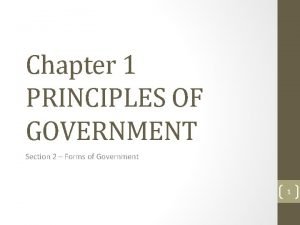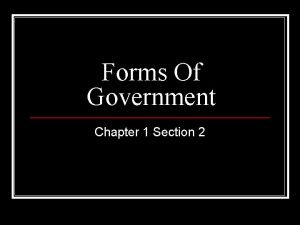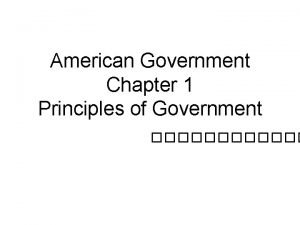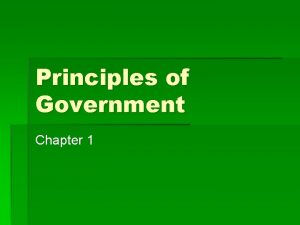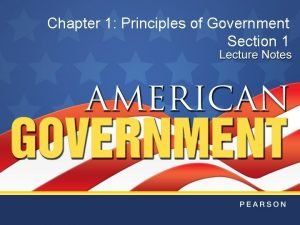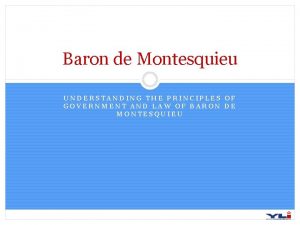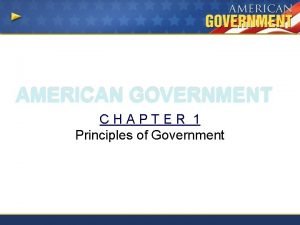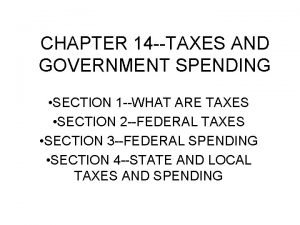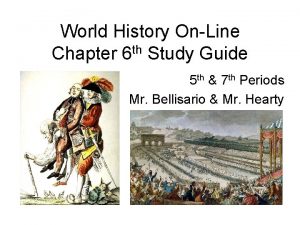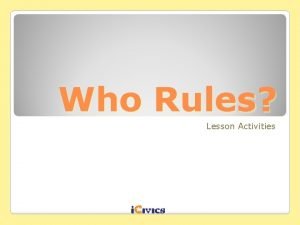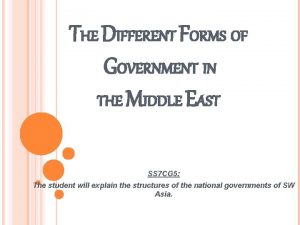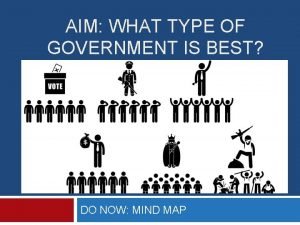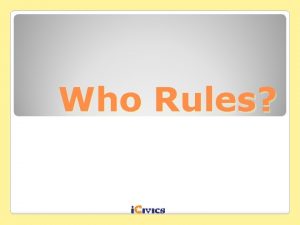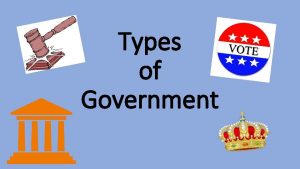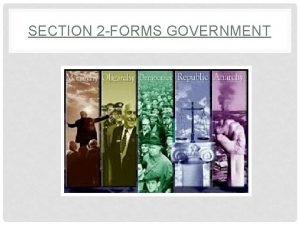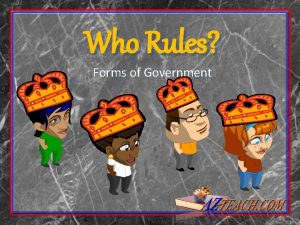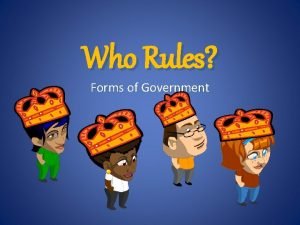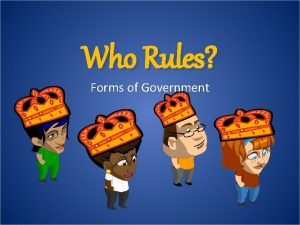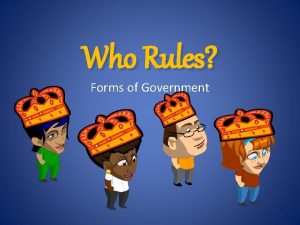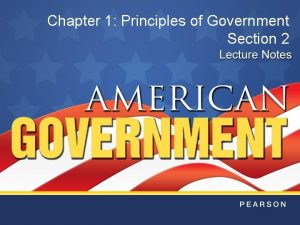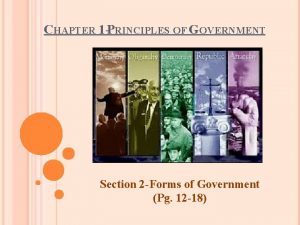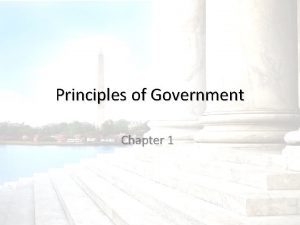Chapter 1 PRINCIPLES OF GOVERNMENT Section 2 Forms

















- Slides: 17

Chapter 1 PRINCIPLES OF GOVERNMENT Section 2 – Forms of Government 1

GUIDING QUESTION: • What are some forms of government in the world today? 2

OBJECTIVES • Classify governments according to 3 sets of characteristics. • Define systems of government based on who can participate. • Identify different ways that power can be distributed, geographically, within a state. • Describe a government by how power is distributed between the executive branch and the legislative branch. 3

In Brief: • Each government is unique, but governments can be grouped into categories according to 3 sets of characteristics. • Democratic governments rely on the participation of the people, while dictatorships concentrate power in the hands of a few. • The distribution of power between local governments & a central government determines whether a government is unitary, federal, or confederate. • Presidential governments divide power among several branches of government, while parliamentary governments focus power in one dominant branch. 4

FACTS: • Political scientists classify governments based on • who participates (# of people participating in the governmental process), • geographic distribution of power, and • the relationship between the legislative and executive. • In a democracy, supreme authority rests with the people. In representative democracies, citizens choose representatives who act on their behalf. • In dictatorships, rulers are not accountable to the people. 5

ENDURING UNDERSTANDINGS: • The geographic distribution of power determines whether a government is unitary, federal, or confederate. • In presidential government, the executive & legislative branches share power. • In parliamentary government, the legislative branch dominates. 6

Terms to Know: • Autocracy - A form of government in which a single person holds unlimited power. • Oligarchy - A form of government in which the power to rule is held by a small, usually self-appointed elite. • Unitary Government - A centralized government in which all government powers belong to a single, central agency. • Federal Government - A form of government in which powers are divided between a central government and several local governments. 7

Terms to Know: • Division of Powers - Basic principle of federalism; the constitutional provisions by which governmental powers are divided on a geographic basis (in the United States, between the National Government and the States) • Confederation - A joining of several groups for a common purpose. • Presidential Government - A form of government in which the executive and legislative branches of the government are separate, independent, and coequal. • Parliamentary Government - A form of government in which the executive branch is made up of the prime minister, or premier, and that official’s cabinet. 8

You can group most of the world’s governments into categories by asking 3 specific questions about each government. For example: The U. S. is a democracy with a federal and presidential system of government. 9

3 Questions to Classify Governments: • Who can participate in the governing process? • How is the government’s power distributed geographically within the state? • What is the relationship between the legislative (lawmaking) and the executive (law-executing) branches of government? 10

Continuing with the U. S. Example: The US is a representative democracy (republic)… Voters elect representatives to act on their behalf in government. The government acts on behalf of the people and gets its power from them. The US has a federal government… Power is divided among the national (federal) government and state (local) governments. (Federalism) The US national government power is divided among the branches of government… The executive and legislative branches are separate, independent, and coequal. 11

In a democracy… the government is responsible to the people (the people it governs). 12

In a dictatorship… the government is responsible to NO ONE. * The person(s) in power has (have) the final authority. 13

What’s the difference between an autocracy & an oligarchy? • In an autocracy a single person holds the power - unlimited political power. • In an oligarchy a small group (usually self-appointed elite) holds the power. 14

GEOGRAPHIC DISTRIBUTIONS OF POWER Type of Government Explanation/Description of Power Example UNITARY The central government create local units of government for its own convenience. Those local governments have only those powers that the central government chooses to give them. Great Britain FEDERAL An authority superior to BOTH the central and local government (Constitution) makes this division of powers on a geographic basis and that division cannot be changed by either the local or national level acting alone. Both levels act directly on the people through their own set of laws, officials, and agencies. United States CONFEDERATE An alliance of independent states; A central organization has the power to handle only those matters that the member states have assigned to it; Typically have had limited powers and only in such fields as defense & foreign affairs; Typically do not have power to make laws that apply directly to individuals (at least not without further action by member states). Rare today. European Union 15

Government may take a presidential or parliamentary form. PRESIDENTIAL PARLIAMENTARY • Each branch is independent and coequal. • The executive consists of members of the legislative branch. 16

Governments can also be classified by WHO can participate. DICTATORSHIP DEMOCRACY • NOT accountable to the people • People hold political authority directly or through representatives. 17
 Chapter 1 section 2
Chapter 1 section 2 Chapter 1 section 2 forms of government
Chapter 1 section 2 forms of government Principles of government chapter 1 answers
Principles of government chapter 1 answers Principles of government chapter 1
Principles of government chapter 1 Chapter 1 principles of government answer key
Chapter 1 principles of government answer key Chapter 1 section 1 government and the state
Chapter 1 section 1 government and the state Chapter 1 principles of government study guide answer key
Chapter 1 principles of government study guide answer key Chapter 1 principles of government
Chapter 1 principles of government Chapter 14: taxes and government spending section 1
Chapter 14: taxes and government spending section 1 National powers
National powers What are forms of government
What are forms of government One important result of the estates-general was
One important result of the estates-general was Different types of government
Different types of government Different forms of government
Different forms of government Different forms of government
Different forms of government Forms of government
Forms of government Types of government
Types of government Chapter 2 principles of ecology test answers
Chapter 2 principles of ecology test answers
